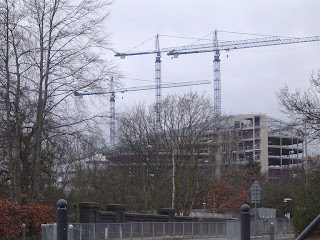Birmingham's superhospital to retain royal title
With 15 months to go before opening, the new super-hospital being built in Edgbaston has been named as the Queen Elizabeth Hospital Birmingham, Historic day for Queen Elizabeth Hospital in Birmingham. The name continues the link of the current Queen Elizabeth Hospital which was given the title following it's association with the Queen Mother.
Four names were shortlisted for the new name of the hospital before being put before over 500 people including staff, members of the public and foundation trust members. The new name was the overwhelming favourite, with many people people already calling it the new Queen Elizabeth Hospital anyway. The trust had to seek the approval of Queen through the Ministry of Justice before approval was given as any building or organisation that carries a royal title has to be given royal approval.
The hospital, the largest single-site development of its kind in the UK will replace the Queen Elizabeth and Selly Oak hospitals and is Birmingham's first acute hospital in 70 years. A phased move will see all services currently at the Queen Elizabeth and Selly Oak hospitals relocated to the new hospital by August 2012.
A few photographs of the hospital under construction from February and January 2008 respectively are shown below.


The scale of the new hospital is immense as the photos above show. 10,000 tons of steel were use alone on the project while 55,000 metres of concrete foundation piles have been bored into the ground.
The hospital will have 30 theatres, 23 inpatient and 7 day case theatres, 44% of inpatient beds will be in single rooms with the remainder four-bed rooms and all inpatient bedrooms having ensuite bathrooms.
A map of 'what goes where' is shown below, reproduced from http://www.uhb.nhs.uk/NewHospital/whatgoeswhere.html

1. Main entrance
2. Drop-off loop
3. Outpatients
4. Ward towers
5. Accident & Emergency
6. Education Centre
7. Sky bridge leading to the Cancer Centre
8. Critical Care
9. Imaging
10. Car parks
11. Day Case
12. Theatres
13. University of Birmingham Research Facility
Artists impressions of the hospital are shown below:




Images reproduced from http://www.uhb.nhs.uk/NewHospital/gallery.html
Current images of the site from February 2009 are reproduced below from http://www.uhb.nhs.uk/NewHospital/gallery.html



Four names were shortlisted for the new name of the hospital before being put before over 500 people including staff, members of the public and foundation trust members. The new name was the overwhelming favourite, with many people people already calling it the new Queen Elizabeth Hospital anyway. The trust had to seek the approval of Queen through the Ministry of Justice before approval was given as any building or organisation that carries a royal title has to be given royal approval.
The hospital, the largest single-site development of its kind in the UK will replace the Queen Elizabeth and Selly Oak hospitals and is Birmingham's first acute hospital in 70 years. A phased move will see all services currently at the Queen Elizabeth and Selly Oak hospitals relocated to the new hospital by August 2012.
A few photographs of the hospital under construction from February and January 2008 respectively are shown below.


The scale of the new hospital is immense as the photos above show. 10,000 tons of steel were use alone on the project while 55,000 metres of concrete foundation piles have been bored into the ground.
The hospital will have 30 theatres, 23 inpatient and 7 day case theatres, 44% of inpatient beds will be in single rooms with the remainder four-bed rooms and all inpatient bedrooms having ensuite bathrooms.
A map of 'what goes where' is shown below, reproduced from http://www.uhb.nhs.uk/NewHospital/whatgoeswhere.html

1. Main entrance
2. Drop-off loop
3. Outpatients
4. Ward towers
5. Accident & Emergency
6. Education Centre
7. Sky bridge leading to the Cancer Centre
8. Critical Care
9. Imaging
10. Car parks
11. Day Case
12. Theatres
13. University of Birmingham Research Facility
Artists impressions of the hospital are shown below:




Images reproduced from http://www.uhb.nhs.uk/NewHospital/gallery.html
Current images of the site from February 2009 are reproduced below from http://www.uhb.nhs.uk/NewHospital/gallery.html





Comments